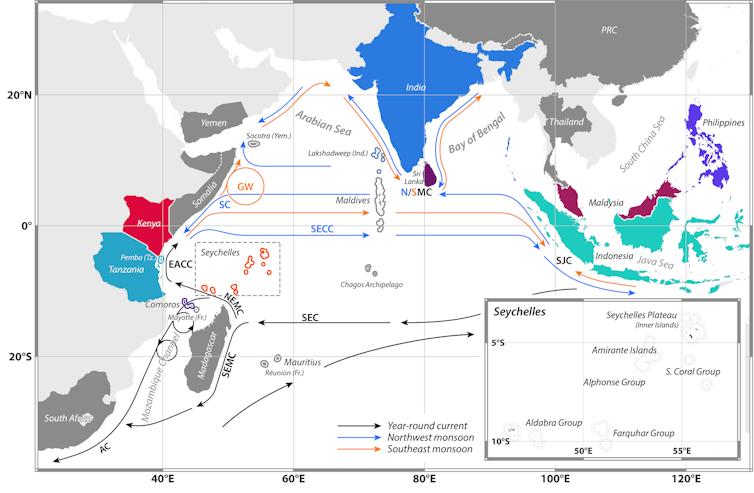
Noam Vogt-Vincent, University of Oxford and April Burt, University of Oxford
More than 1,000km southwest of Mahé, the main inhabited island in Seychelles, lies a ring of coral islands called the Aldabra Atoll. The islands are a Unesco world heritage site and support a huge diversity of marine species including manta rays and tiger sharks. The atoll is also a breeding site for endangered green turtles.
Aldabra has long been protected from threats to its biodiversity by its remoteness. But now plastic debris is strewn across Aldabra’s coastlines, threatening nearby marine ecosystems. Research finds the likelihood of coral disease increases from 4% to 89% when coral are in contact with plastic.
The Seychelles Islands Foundation, who are responsible for managing Aldabra, conducted a plastic clean-up operation in partnership with Oxford University in 2019. Roughly 25 tonnes of plastic waste were removed from the islands.
A new study that we co-authored modelled the flow of plastic debris in the Indian Ocean between 1993 and 2019 and traced it to its source. We found that none of the plastic that washes up on Aldabra comes from the islands themselves.

Simulating plastic flow
Using data on plastic waste generation and fishing activity, we generated hundreds of billions of virtual plastic particles entering the Indian ocean. We then simulated their movement based on ocean currents, waves and winds.
Bottle caps and other low-buoyancy items sink fast and plastic loses buoyancy as it fragments or becomes covered in waterborne organisms. Items that remain buoyant for longer are transported further distances. To reach Aldabra from the eastern Indian Ocean, our model estimates that debris must be floating for at least six months.
We determined the likelihood that this debris would wash up on the coast by analysing the rate at which scientific “drifters” (instruments that record ocean currents) and GPS-tracked floating fishing devices become “beached”. Free-floating instruments such as these behave well as proxies for floating plastic. These observations indicate that around 3% of the debris that is within 10km of a coast beaches each day.
Island under siege
Our model predicts that Indonesia is responsible for most of the plastic debris, including as flip-flops and plastic packaging, that beaches across Seychelles. Various other countries including India, Sri Lanka and the Philippines are also major sources.

But Seychelles is also contaminated with plastic waste from other places.
Almost half of the plastic bottles found on Aldabra during the initial clean-up had been manufactured in China. But ocean currents do not flow directly between China and the western Indian Ocean. It is thus unlikely that a large number of bottles could float from China to Seychelles.
But Seychelles is close to a major shipping lane that connects southeast Asia to the Atlantic. If bottles were discarded from ships crossing the Indian Ocean then they would likely beach across Seychelles.
Research that we conducted in 2020 estimated that the fishing industry was responsible for 83% of the plastic waste on Aldabra. Most of the fishing gear abandoned by “purse seine” fisheries (a method of fishing that employs large nets to catch tuna) likely relates to regional fishing activity around Seychelles. But abandoned gear from longline fisheries may have drifted in from as far afield as western Australia.
Perhaps most importantly, our modelling also suggests that the rates at which plastic debris will beach in the Indian Ocean will follow strong seasonal cycles.
Winds tend to have a southerly (northward) component during the Indian Ocean’s summer monsoon season. But major debris sources such as Indonesia and India share similar, or more northerly, latitudes with Seychelles. During this period, debris from these sources tends to miss Seychelles and is transported further north.
By contrast, the winds reverse during the winter monsoons and transport debris directly towards Seychelles. We expect plastic debris accumulation to peak in Seychelles shortly after the winter monsoons (February to April). In the southernmost islands, almost all of the debris that beaches will do so at this point.

Planning effective mitigation
Seychelles is not responsible for generating this waste but face mounting environmental and economic costs. For example, 500 tonnes of litter remained following the initial clean-up of Aldabra’s coasts, which may cost up to US$5 million (£4 million) to remove.
The United Nations last year agreed to establish a global plastic treaty that will tackle plastic pollution at its roots. But negotiations only began recently and it may be a long time before the treaty has any meaningful impact.

Until then our modelling may help to establish other strategies to reduce the accumulation of plastic debris in Seychelles.
We identified fishing gear and shipping as being responsible for the majority of plastic pollution on Seychelles. Better enforcement of existing laws such as the 1983 ban on the disposal of plastic into the sea under the Marpol Convention should reduce the amount of plastic entering the Indian Ocean.
Predicting the peak of plastic accumulation in Seychelles will also maximise the effectiveness of beach clean-ups. Removing litter shortly after its arrival will minimise the time debris spends being broken down into unmanageable fragments.
Remote Indian Ocean islands are increasingly affected by plastic waste generated overseas. But by modelling the flow of plastic debris, we now have the chance to develop more effective strategies to reduce plastic accumulation and strengthen demands for stronger commitments under the global plastic treaty.

Don’t have time to read about climate change as much as you’d like?
Get a weekly roundup in your inbox instead. Every Wednesday, The Conversation’s environment editor writes Imagine, a short email that goes a little deeper into just one climate issue. Join the 10,000+ readers who’ve subscribed so far.![]()
Noam Vogt-Vincent, DPhil Candidate in Earth Sciences, University of Oxford and April Burt, Research Associate, University of Oxford
This article is republished from The Conversation under a Creative Commons license. Read the original article.

